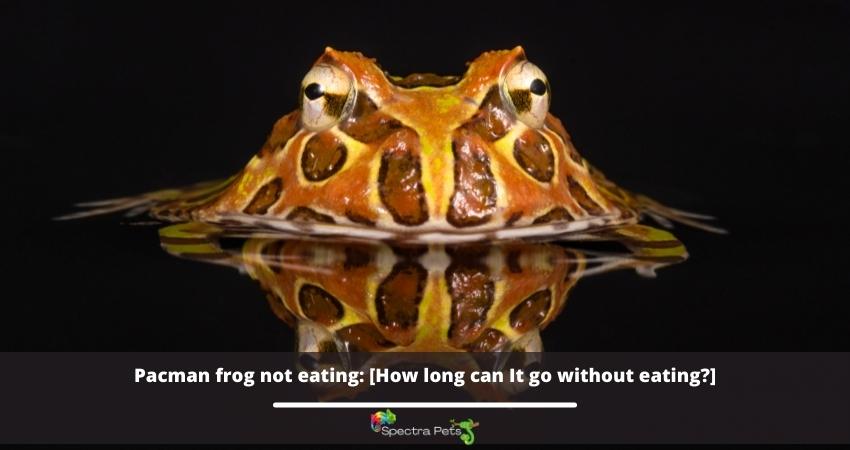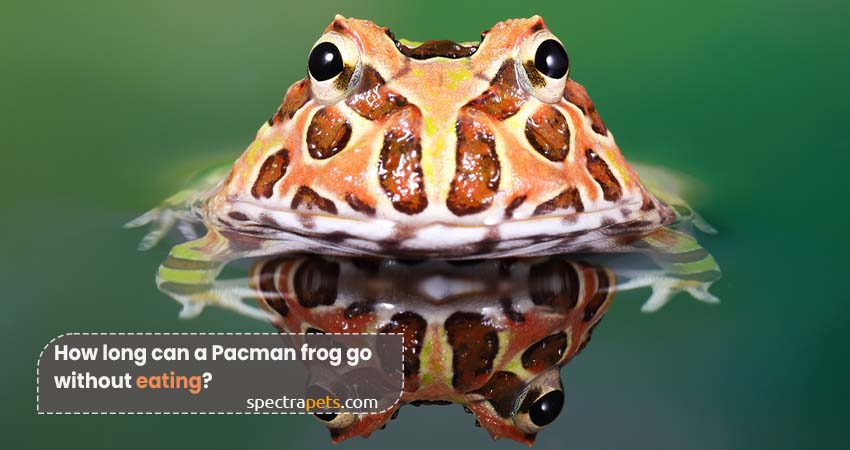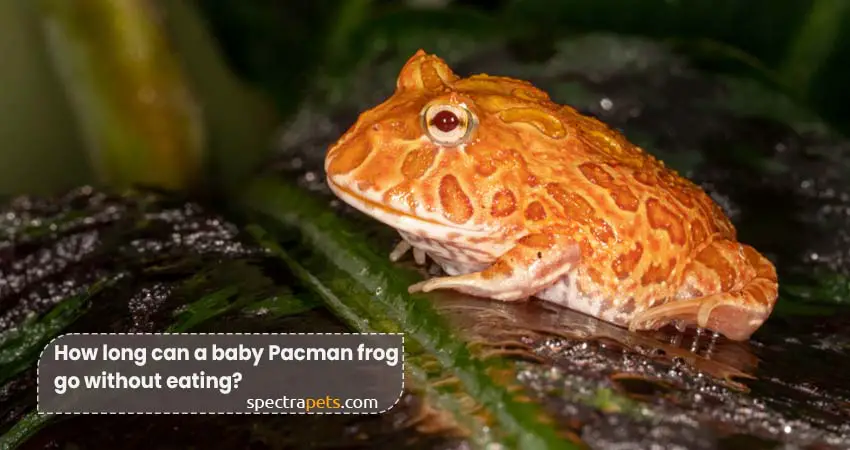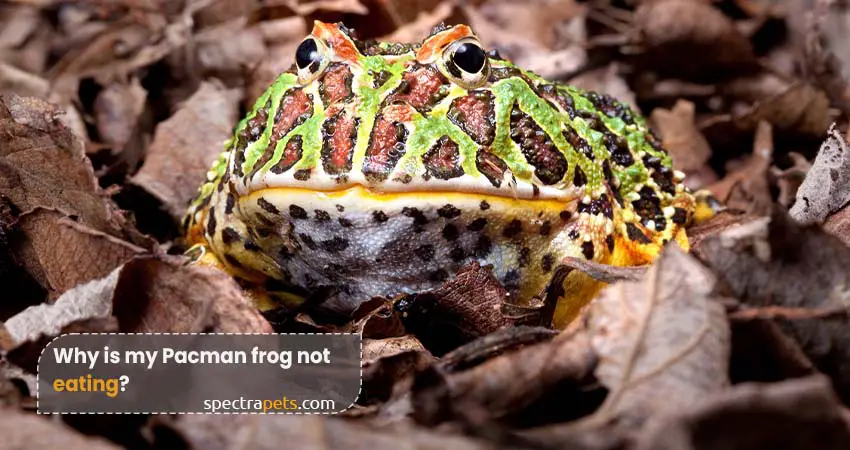Many people do not know that the Pacman frog sometimes stops eating for a long time. Especially if you are new, it may be awkward and anxious. But, relax, that’s a natural phenomenon.
Veteran frog owners are so chill about it, as they know that it’s just a part of their lives. A pacman frog can go without eating up to a month.
In one sense, it’s good because it gives you the chance to take a more closer look at your shy Pacman frog. You will take action by finding out the hidden reason behind the loss of appetite.
So, keep reading to learn how long can a Pacman frog go without eating and all other relevant details that will turn you into an expert on the Pacman frog.

How long can a Pacman frog go without eating? [Should You Be Worried?]
For a new pet frog owner, it would be a tense moment to see the Pacman frog live without consuming any food. But that’s quite normal for this species due to their slow metabolism pattern.
It’s mostly in the wintertime when this frog adopts the ”no eating mood”. However, you will still see them doing it during the scorching summer months. You’re right, they can still do it in the summer sometimes.

The bottom line is an adult Pacman frog can go without food for a week, month, or even more than 1 month. As long as it does not happen because of sickness, there’s little room to worry.
However, as an owner of this amazing frog, you should ensure that any sickness or other external issue isn’t the cause. Sometimes it can be one of the reasons for not eating food for a long time.
How long can a baby Pacman frog go without eating?
Don’t panic when your baby Pacman frog does not eat for a few days. As they came into a new environment, they might not eat from 3-4 days up to 1 week or even more.
However, if it stretches for too long then you should take initiative to feed it using some technique. But you should observe the frog for at least 1 week. After 7 days, if it starts eating, it’s good, if not, force-feed it.

Try to feed normally with some technique
Provide live food to spark interest in hunting & eating. It might work or not work you never know. Feeding the baby frog at nighttime might be a good choice rather than providing it during the daytime. Why? Because they are nocturnal and tend to hunt prey at night time.
You can alter the feeding pattern by not doing hand-feeding. Try to feed the baby frog using a thong. Take your pet frog out of the terrarium and put him/her in a new container. Then give alive or insects for feeding.
Force-feeding
When none of the above-mentioned techniques works, you should try force-feeding. Though it sounds a bit aggressive, you should be handling it very softly. You will need a wet paper towel, some flat toothpicks, and toothpicks for dry or alive food.
Let someone hold the frog with the wet paper towel. And you take a small piece of food and try to push it slowly inside the frog’s mouth. Have patience while doing it. It may refuse for the first few minutes but eventually eat it. Make sure you don’t hurt the little buddy.
Why is my Pacman frog not eating?

Without proper investigation, it would be hard for you to know why the frog is acting weird and refraining from eating food. You are lucky as I brought some points that would help you track down & solve the problem if it gets serious. Let’s have a glimpse of some possible underlying reasons which can be a trigger for your frog’s loss of appetite.
1. Temperature
An inappropriate temperature is one of those which is responsible for creating a loss of appetite in your Pacman frog. Just like another amphibian, your frog needs the right temperature for its flawless digestion of food.
A too low or too high temperature will make it harder for the frog to digest its food. So always monitor it while it’s enjoying time inside the terrarium at the optimum temperature. A digital thermometer would be good for that. So, what’s the optimum temperature range for the Pacman frog?
For daytime, Pacman you should maintain between 75-degree Fahrenheit to 85-degree Fahrenheit. While for nighttime, you need to ensure 65-degree to 75-degree temperatures.
2. Humidity
Pacman frog belongs to mostly jungles and the high vegetation area close to human settlements. This South American frog requires at least 50-80% humidity for its normal body function.
The absence of proper moisture inside the air of the tank will hamper the frog’s ability to breathe smoothly. And there’s no doubt breathing difficulty is a serious health issue. So due to that, they can stop taking food for a long time. Using a high-quality hygrometer, you can easily check the humidity level of the frog tank.
3. New environment/ New home
It’s nothing unusual for a feel to stress a bit for a few days when you bring into a new terrarium. The change in the environment and place is unknown for the Pacman frog so it can take some time to settle down.
In such a case, you don’t need to stress out. Make sure it’s not losing its body weight. If it poops from time to time and that looks normal then you can stay relaxed. Give him/her a few days to get into the mood.
4. Impaction
When it comes to eating, Pacman frog is a boss grabber. They’re gonna grab & eat any life that moves in front of their mouth, especially if it is a crispy insect.
These guys have bad records of eating stuff that’s not suitable for their mouth size. To check if your frog is impacted or not, you need to softly touch the belly of your Pacman frog (of course with caution!). It feels like a hard lump, which suggests that he/she ate something that was not suitable for their size.
They are notorious for eating substrate or even a larger size pray. From your side, you must ensure you are not giving them food that they can’t digest smoothly.
However, if you see the presence of a hard object from the belly skin, then he/she needs your help immediately. You can soak the frog in lukewarm water and softly rub the belly to help it poop. If it does not poop, you need to call a vet. Lastly, if you don’t; notice any hard lump then the problem of not eating food is something else.
5. Estivation
This is a phase that the Pacman frog can adapt to when things do not go right. During this stage, your amphibian pet will let its body function at a very slow rate. Also, it will start to surround itself with a dry skin cocoon.
They can do it due to low-level moisture and dig down themselves deep inside the substrate layer. So that they can keep surviving by taking moisture from the substrate.
So it’s your responsibility to find out if the case is like that. And simply take action by fixing the climate inside the tank. Right weather will let the frog come out from the deep substrate. Then, if you notice any dry cocoon, you should help your frog so that it can easily do the shredding. All you have to do is to soak the Lil buddy in fresh water and finally give him/her some food.
6. Sick frog
Pacman frogs limit their food consumption when sick like other animals. Though in captivity you will be dealing with & take care of the frog with precaution, the chances of getting affected by the virus, fungus, bacteria, and parasites remain.
However, you can track a sick Pacman frog by tracking the abnormal stool, irregular stool, and weight loss of the frog. Any of these signs means your frog is in trouble and it needs help.
Final words
What can be better when you know even if the Pacman frog does not eat, you still know why it’s not eating and how to feed it.
Simply using the things that I talked about in a bit detailed you can easily deal with your frog that raised a red flag on food. You as the frog owner can do the right job & give him the green signal to continue eating again.
If all these words help to get back things to normal then simply have look at my other article which will enrich your knowledge basket.

